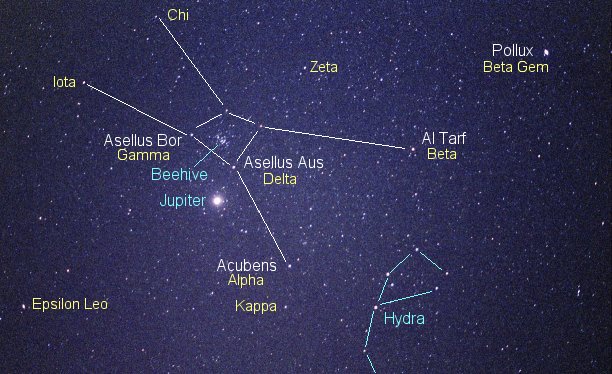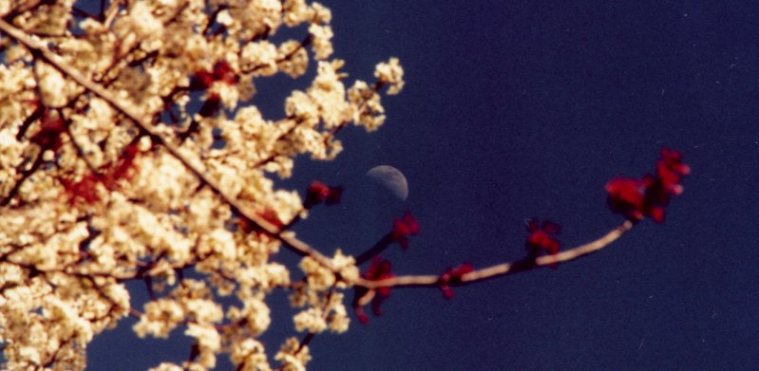Well, Margarita, I can't resist - just because you started talking about U Orionis (not to be confused with Upsilon Orionis), I can't resist talking about Upsilon Orionis. And why? For two reasons. Upsilon Orionis was the Star of the Week quite recently, on March 14, 2014. But also because Upsilon Orionis caught my attention when I was checking up the color indexes of some 5,000 stars in my attempt to find the bluest ones. And yes, Upsilon Orionis turned out to be one of the true sapphires of the sky!
(Yes. I know. The B-V index doesn't tell us how
intrinsically blue a star is, just how blue it appears to be from our own vantage point. Still, that is sufficiently interesting to me!)
The B-V index of Ups Ori is -0.26. Extremely few stars look bluer in our skies. The bluest-looking moderately bright star in the heavens is Mu Columba, a 5.1 mag 09/B0/B1 main sequence star about 1300 light-years away. Interestingly, Mu Columba is a runaway star that has been ejected from Orion, from the Iota Orionis region. The B-V index of Mu Columba has been measured as -0.27, -0,29, -0.30 and -0.31. Most likely, the brilliantly blue color of Mu Columba is due to the fact that we probably see it pole on, where it is hotter and bluer than at the equator, and that it is currently located in a region where there is very little dust along the line of sight to us.
But I find the spectral class of Mu Columba interesting, too. Upsilon Orionis has a very similar spectral class, although it appears to be a more massive and luminous star. The uncertain distance to Upsilon Orionis may be around 2,900 light-years, and its luminosity in V light may be as much as 9,000 Suns. That is a lot, and it is unusual. And the bolometric (total) luminosity of Upsilon Orionis may be considerably more than 100,000 Suns.
Jim Kaler wrote:
The star is a whopper, a luminous class B0 dwarf (right at the edge of class O) at a most likely distance of 2960 light years. It's so far away, however, that parallax becomes unreliable, the formal uncertainties placing it as far as 3670 light years or as close as 2350. Upsilon may be part of the Orion OB1c association of hot massive stars, those in the region of Orion's Sword, but even at its statistically closest, it's notably farther than the Sword association's mean distance of 1650 light years. Given how far away it is, it's a bit surprising that Upsilon is dimmed just 0.13 magnitudes by interstellar dust. From its magnitude, the distance, and a temperature of 32,440 Kelvin needed to account for a lot of invisible ultraviolet radiation, we find a huge luminosity of 173,000 times that of the Sun, double that of Betelgeuse and Rigel, though not reaching the level of Theta-1 C. (At its likely closest, the luminosity drops to 116,000 Suns, still pretty impressive.) Temperature and luminosity then conspire to give a radius of 13.2 times solar. The projected equatorial rotation speed of just 15 kilometers per second is low, probably because the rotation pole is more or less directed at us, as for such stars we would expect more than ten times that speed. Theory tells of a huge mass of 30 Suns, with distance uncertainties allowing a range of 25 to 35. The great luminosity forces a wind that blows billions of times the strength of the solar wind. Now about halfway through its 5.5 million year dwarf lifetime, there is little question that Upsilon Orionis is going to blow up someday as a grand supernova, leaving behind a neutron star or even a black hole. Unfortunately, there seems to be no companion to interact with the proceedings and perhaps to tell us more.
So like Mu Columba, Upsilon Orionis is a likely pole-on main sequence star of spectral class B0, and it is very little dimmed by dust. Both stars are
blue indeed.
Another remarkably blue B0V-type star is Tau Scorpii. Okay, its B-V index is "only" -0.21, but that is in fact quite blue - believe me, I know! And Tau Sco is likely a pole-on star. Is it located in a dust-free region? I doubt it, because it is not too far away from the great dust clouds of Antares and Rho Ophiuchi, but clearly it is a lot less dust-reddened than most other stars in the same region.
All three B0V stars that I have discussed here have one more thing in common: they appear to be single stars.
And I for one find these blue B0V jewels extraordinary!
Ann
P.S. Read about Upsilon Orionis
here, too.


